Canadian Aquaculture R&D Review 2007
Finfish - Salmon
BC study compares natural and synthetic pigments
Which is better for the fish?
Which is better for the bottom line?
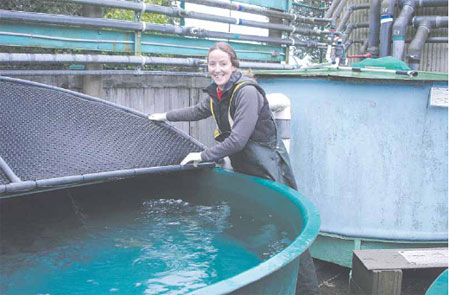
Dr. Fiona Cubitt by one of her experimental tanks.
A four-month study conducted through the Centre for Aquaculture and Environmental Research at the University of British Columbia confirms that farmed Chinook salmon derive significant benefits from astaxanthin being added to their feed.
Carotenoids - the family of pigments to which astaxanthin belongs - have previously been identified as enhancing both survival and antioxidant function in fish.
But the study, part of a much larger interdisciplinary project regarding the costs and benefits of a potential organic aquaculture industry for Canada, has yet to have all of its data collated, tabulated and analysed.
As a result, says principal investigator and research associate Dr. Fiona Cubitt, there are only a few preliminary observations which can be made.
One of those, she indicated, is that young chinook salmon typically do not start taking up the pigmentation - whether from a natural source or a synthetic source - until the fish have reached a certain point in their development.
In general, said Cubitt, they don't begin taking it into their flesh until they reach roughly 100 grams.
When they do, said Cubitt, there is a marked difference in color between the larger and smaller fish and between those fed the pigment and those on a control diet with no pigment.
Researchers at the centre started growing nine groups of chinook salmon in separate 4,000-litre outdoor tanks at the facility in June 2006, beginning with fish of about 50 grams. By mid-September, the halfway point in the study, they had grown to an average of 110 grams, and were expected to rise to close to 200 grams by the end of the project.
The program is designed mainly to draw comparisons between natural- and synthetic source astaxanthin as flesh-pigmenting materials for post-smolt chinook, looking at a variety of factors such as industry costs, as well as health and growth benefits. The feed additive is known to provide antioxidant health benefits, but concerns have been raised about the two potential sources for it: from krill in the wild, or from purely synthetic methods of production.
In order to investigate issues associated with organic aquaculture, Cubitt and her associates looked at both synthetically-synthesized astaxanthin and astaxanthin made from natural sources using Phaffia yeast. The fish were sampled for assessment every eight weeks, with data taken on length, weight, growth, pigmentation, and condition factors - using health and welfare indicators.
With the aid of fish-nutritionist Dr. David Higgs, the researchers made up their own feeds with ingredients obtained from companies such as EWOS Canada, mixing the materials, adding fish oil and making their own pellets.
The fish were hand-fed to satiation morning and afternoon, and Cubitt said it was very important to calculate the exact amount of the different kinds of feed each population of fish was eating.
"There have been three of us doing the feeding, so it has been a pretty labour-intensive project," said Cubitt.
Cubitt noted that both astaxanthin and castaxanthin, both of which are used in salmonid aquaculture, are naturally-occurring substances shown to enhance liver and antioxidant function in fish, and conventional fish-farming practice has been to use the two compounds generated from synthetic sources.
Cubitt said though that as fish farmers have increasingly demanded the antioxidants from natural sources, the variety, predictability, cost and quality of those products have also climbed. It has also been suggested that they aren't as effective or predictable as the synthetically-produced pigments - and so may not give the same health benefits. It's that which has led to an investigation to look at the effects of one of the newest natural-source astaxanthin (products) on the market, in a commercial replicated comparison between synthetically- and naturally- produced astaxanthin.
Research team: K.F. Cubitt, A. Chan, J. Mann, J. Henry, S. McKinley and D.A. Higgs. For information contact K.F. Cubitt (Email: kfcubitt@interchange.ubc.ca) or D.A. Higgs (Email: higgsd@dfo-mpo.gc.ca). Submitted by DFO/UBC Centre for Aquaculture and Environmental Research.
Jun.-Nov.'06
Researchers study fate of fish pellets on seabed floor
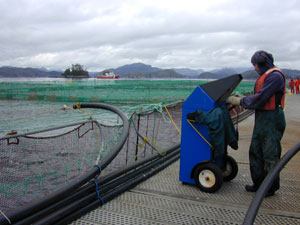
DFO research vessel and feed-detection system on fish farm.
Dr. Terri Sutherland spends a lot of time watching how different feed pellets react to different flows in a laboratory water-circulation system.
Sutherland is the principal investigator in an ongoing project to eventually put together a chart or matrix of what different sizes and types of fish-feed pellets do once they’ve passed through the fish pens and settled on the ocean floor.
Sutherland, a research scientist at the Centre for Aquaculture and Environmental Research run by the Department of Fisheries and Oceans and the University of British Columbia in Vancouver, initially did some field work on the subject in Maine during the mid-1990s.
Now she and colleagues at the centre and at the University of Southampton in England are refining some of that early work to help fish farmers and others predict more accurately how both feed and fecal waste from the farms will be dispersed over the ocean floor.
The factors that have to be taken into account are quite complex and not necessarily in direct relationship to each other, says Sutherland; and the project has just started to tie some of them together in the hope of one day coming up with a matrix of predictions which can be used in conjunction with the farm-footprint modelling system, Depomod, used by DFO.
Generally speaking, Sutherland said, the rule is that the larger the diameter of the coated pellet, the faster it settles to the bottom and the more effort it will take to put it back into suspension.
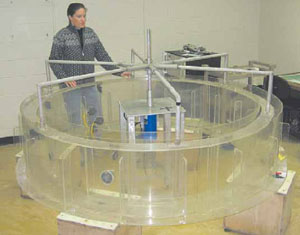
Dr. Sutherland with circular flume.
What’s more, says Sutherland, different diets make pellets of different densities; water varies in density between summer and winter temperatures; and the extent to which the pellet will "stick" to the ocean floor will depend on the topography and composition of the substrate, whether it is clay or silt, rock or sand.
Sutherland says that the researchers have been putting different kinds of substrate into the bottom of a special circular laboratory flume which has a viewing panel in the side which allows the motion of the pellets to be videotaped. The plastic device, which is also fitted inside with measuring devices, was designed by Dr. Carl Amos and developed for studies by the Geological Survey of Canada and the University of Southampton. The researchers also have a similar version of the flume, which can be dropped to the ocean floor below a farm site.
To date, said Sutherland, she and her colleagues have looked only at winter feeds of different sizes – from 3.5 to 11 mms in diameter – from Skretting, but she said they intend to look at summer diets next year.
Additional work will also be done on analysing the chemical composition of the pellets for water, organic, carbon and nitrogen content, as well as stable carbon and nitrogen isotopes, and identifying potential tracers of waste material.
Research team: T.F. Sutherland, C.L. Amos, C. Ridley, I.G. Droppo, S.A. Petersen. For information contact T.F. Sutherland (Email: sutherlandt@pac.dfo-mpo.gc.ca). Submitted by DFO/UBC Centre for Aquaculture and Environmental Research.
Early prediction of harmful algae blooms in New Brunswick
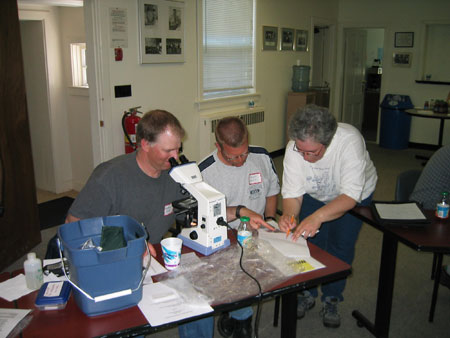
Training of farm staff in the collection and identification of phytoplankton.
This project investigated the feasibility and cost-effectiveness of several potential early warning approaches for predicting harmful phytoplankton blooms at salmon farms. The components of this project included: training farm personnel on the identification of harmful algal species; implementing daily phytoplankton monitoring by farm staff at selected salmon farms in southwestern New Brunswick; retrospective analyses of existing monitoring data; laboratory experiments to determine threshold concentrations of selected harmful phytoplankton species which cause problems for farmed salmon; water circulation studies to determine the spatial and temporal origin of water (which could transport phytoplankton blooms) entering salmon farms; evaluation of the effectiveness of a light sensor array for bloom detection; and evaluation of the usefulness of satellite imagery for bloom detection. The field and laboratory programs were completed in 2004 and 2005, with the collaboration of 4 salmon farms in each year. Data analysis and report preparation are mostly completed and the project will end in March 2007.
Research team: Blythe Chang (SABS, DFO) Jennifer Martin, Fred Page, Les Burridge, Murielle LeGresley, Alex Hanke, Paul McCurdy, Glen Harrison, Ed Horne. For information contact Blythe Chang (Email: changb@mar.dfo-mpo.gc.ca). Submitted by DFO (ACRDP)
Jun. ’04-Mar. ’07.
Testing recombinant vaccines for fish aquaculture
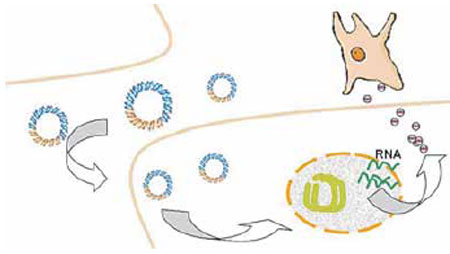
DNA vaccines are synthetic DNA constructs. They are taken up by the host cell, transcribed into immunogenic proteins and released into circulation where antigen presenting cells will take them up.
Infectious diseases present a significant economic burden to finfish aquaculture industries and there is concern that diseases may also negatively impact wild fish populations. Fish vaccines are used against various diseases and have reduced the environmental impact of diseases and improved animal welfare. However, few anti-viral vaccines are available leaving the industry without tools to prevent many viral diseases.
DNA vaccines are an alternative to traditional vaccines offering some advantages, e.g. safety, activation of several immune mechanisms in the host, multivalent vaccination possibility, high stability, relatively low cost, etc. However, these promising DNA vaccines are still in the early stage of design, evaluation and regulation.
Heat shock proteins (HSP) are abundant in cells where they are involved in protein conformation and shuffling. One of their functions is to present antigenic peptides to the immune cells thus triggering an immune response.
In this project, we propose a novel approach for DNA vaccines where we will combine, in a single recombinant DNA plasmid, a sequence for an antigen and a heat shock protein from the host species. A leader sequence is also included in the vector to ensure secretion of the protein from the host cells. As a model disease-host system we selected Nodavirus and Atlantic cod. Different design and delivery approaches will be evaluated during the project.
Research team: Nellie Gagné (DFO), Stewart Johnson (NRC IMB), Laura Brown (NRC IMB), Luis Afonso (NRC IMB). For information contact Nellie Gagné (Email: gagnena@dfo-mpo.gc.ca). Submitted by DFO (ACRDP).
Apr. ’06-Mar. ’08
Management of organic waste & oxygen depletion at salmon farms in New Brunswick
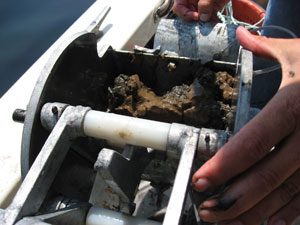
The primary objectives of this project are to examine organic waste deposition and dissolved oxygen depletion around selected salmon farms in the southwestern New Brunswick (SWNB) area of the Bay of Fundy. Current meter deployments and a circulation model will be used to determine the water circulation regime around the farms. Benthic sediment samples will be collected and used, together with existing sediment data, to map the distribution of organic loading in the benthic environment below and around the farms. Data on local bathymetry, farm layout, fish production, feeding and settling rates of organic particles, in conjunction with estimates of water velocity, will be used to test the Scottish DEPOMOD aquaculture waste model. We will also link a particle settling routine to an existing three-dimensional tidal circulation model for the SWNB area. The model results will be compared to the actual benthic data to determine the suitability of these models for predicting organic waste deposition at fish farms in the SWNB area.
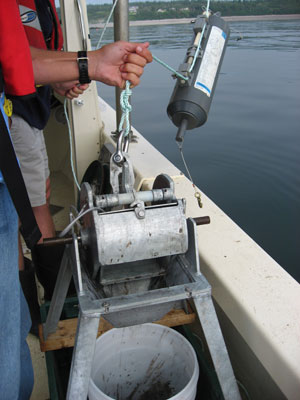
The photos show sediment sampling methodology used at salmon farms in southwestern New Brunswick.
In addition, a simple flux balance numerical model will be used to predict the oxygen concentration within a farm using knowledge of the oxygen concentration at a distance from the farm, the velocity of the current entering the farm, the biomass, size structure and stocking density of the fish within the farm and literature-based estimates of the respiration rates of salmon. The model predictions will be compared with measurements of the temporal and spatial variability of dissolved oxygen levels in the water column within and around the selected salmon farms.
Research team: Fred Page, (SABS, DFO), Blythe Chang, Randy Losier, Paul McCurdy, Joe Crocker. For information contact Fred Page (Email: pagef@mar.dfo-mpo.gc.ca). Submitted by DFO (ACRDP).
Nov. ’05-May ’08.
Evaluation of "Bay Management Areas" for southwest New Brunswick salmon aquaculture
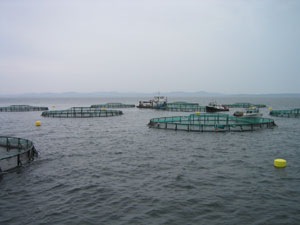
Typical salmon aquaculture in southwestern New Brunswick.
The Sustainability Plan for Atlantic Canada Salmon Farming (published in 2005) noted that "marine sites need to be organized relative to a system of effective bay management areas, based on biophysical environment and risk management (fish health, environment) and infrastructure needs." A workshop held in July 2005 by the salmon farming industry noted that there were several key facts that must be addressed when making improvements to the existing system of Bay Management Areas (BMAs) to support the Sustainability Plan. These include hydrodynamics and circulation, fish health, integration of alternate species, infrastructure, stakeholder interactions, fallow times, balancing production, and supporting growth.
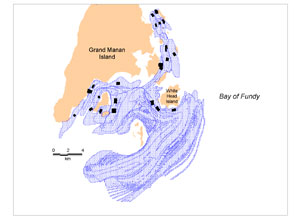
Map showing model derived tidal excursions areas for fish farms in the Grand Manan Island area.
The objectives of this project are to produce a series of two dimensional GIS based maps describing the spatial distribution of aquaculture sites, potential zones of aquaculture impact (i.e. simple estimates of waste dispersal plumes), disease plumes from salmon farms (i.e. tidal excursions) and the distribution of major fishery resources and activities in the coastal zone of the southwest New Brunswick area. The GIS maps will be used to determine the site specific and cumulative overlaps between aquaculture sites and their zones of potential influence with respect to disease and waste dispersal with the major resources and harvesting activities. The cumulative overlaps will be produced for each of several BMA boundary scenarios that will be provided by the salmon industry.
Research team: Fred Page (SABS, DFO), Blythe Chang, Randy Losier. For information contact Fred Page (Email: pagef@mar.dfo-mpo.gc.ca). Submitted by DFO(ACRDP).
Nov. ’05-May ’07
Researchers examine canola oil as a lipid source for chinook pre-smolt
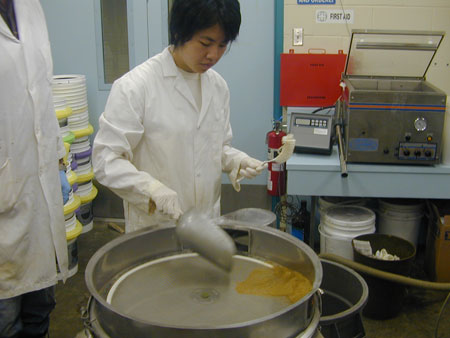
Susie Huang (M.Sc. Student, UBC) showing separation of crumbled pelleted feed into different fractions for fish of different sizes.
A nutrition study was undertaken to determine how the inclusion of different concentrations of canola oil (CO) in the diets of spring chinook salmon (Oncorhynchus tshawytscha) by progressive replacement of anchovy oil affected the growth, health, ionoregulatory development, sea water tolerance, swimming performance and whole body and lipid composition of the fish before and after transfer into sea water. Triplicate groups of spring chinook salmon (initial weight, 0.42-1.9g) were fed one of four isonitrogenous and isoenergetic diets that contained one of four levels of canola oil (CO furnished either 0%, 25%, 50% or 75% of the total dietary lipid content).
Over a 7 month period, diet treatment was not found to significantly affect fish growth, ionoregulatory ability, swimming performance or any aspect of fish health (haematology and immunology). Thus, canola oil was found to be an excellent source of dietary lipid for spring chinook salmon during most of the freshwater residency period of this species. Owing to the rising costs of fish oil in the world commodity market, these findings are of great significance for feed manufacturers and private and government producers of chinook salmon smolts.
Research team: Susie Huang, Colin Brauner, Trish Schulte, Shannon K. Balfry, and Dave A. Higgs. For information contact Dave Higgs (Email: higgsd@dfo-mpo.gc.ca). Submitted by DFO (ACRDP).
May-Dec.’05
Evaluation of feed attractants for chinook salmon
A study is being undertaken to assess the efficacy of various marine protein products as palatability enhancers for salmon. Two types of experimental fish protein hydrolysates (FPH) prepared from Pacific hake (Merluccius productus) using commercially available enzymes along with two commercially prepared FPH’s and a krill product are being tested for their feed attractant qualities using juvenile chinook salmon (Oncorhynchus tshawytscha) in a 35-day study.
Control salmon are being fed a fishmeal and oil-based diet whereas experimental salmon are receiving diets containing soybean meal at a concentration known to depress appetite without or with an identical concentration of each of the aforementioned putative palatability enhancers. It is hoped that one or more of the test palatability sources will partially or fully mask the anti-palatability effects of the constituents originating from the soybean meal and thereby permit more extensive use of this inexpensive plant protein source in diets for this species. Also, we hope that the most effective diet palatability enhancer(s) identified in this study will prove useful for other salmonid species such as Atlantic salmon fed diets extensively based upon plant protein sources. These results may also yield an alternative use for the highly undervalued Pacific hake.
Research team: T. Ho, B. Skura, D.A. Higgs, E. Li-Chan, and B.S. Dosanjh. For information contact Dave Higgs (Email: higgsd@dfo-mpo.gc.ca). Submitted by DFO (ACRDP).
Sept ’06- ongoing
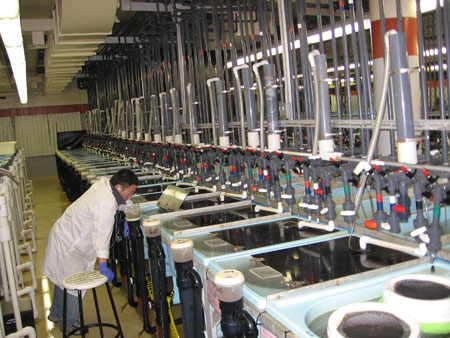
Tom Ho feeding experimental chinook salmon (M.Sc. Student, UBC).
Determining the immune response of Atlantic salmon to infectious salmon anemia virus (ISAV)
Infectious diseases present a significant economic burden to finfish aquaculture industries and there is concern that diseases may also negatively impact wild fish populations. Increasingly, genomic tools are being used to investigate diseases of fish and their causative agents and are beginning to provide scientists, clinicians and regulators with management options. Despite this, very little is known about the diseases and pathogens affecting Canadian finfish culture industries or adjacent wild populations.
Infectious salmon anemia virus (ISAV) is an important virus pathogen of salmonids and causes mass mortalities. It remains a recurrent problem in Eastern Canada and Maine since the initial epizootics of 1996.
In this project, we propose a genomic approach to better understand the diversity of ISAV and to relate this diversity to host responses to infection, the development of disease and the recovery from or resistance to, clinical disease. ISAV isolates will be selected according to their pathogenicity. Atlantic salmons will be exposed to the virus and microarray technology will be used to discover molecular biomarkers of viral infection and resistance mechanisms against ISAV.
Research team: Nellie Gagné, Philip Byrne, Kyle Garver, Simon Jones. For information contact Nellie Gagné (Email: gagnena@dfo-mpo.gc.ca). Submitted by DFO (ACRDP).
Apr. ’05-Mar. ’08
New Brunswick research to characterize strains of ISA in Bay of Fundy
In recent months the ISAV surveillance program operated by the New Brunswick Department of Agriculture, Fisheries and Aquaculture has identified a preponderance of salmon infected with genetically distinct ISAV strains, both of North American and European descent. Some of which seem to be more virulent than others. The apparent disparity in virulence makes management decisions on infected fish difficult in light of many unanswered questions. The existence of different strains, which may or may not be possible to detect with all exiting diagnostics assays, and the inability of these routine assays to differentiate between strains of variable virulence complicates the management of ISAV. Therefore, studies are needed to further characterize isolates at the genetic level and to determine the virulence differences between ISAV strains so that i) rapid economical and improved assays for the differentiation of strains in routine surveillance programs can be developed and ii) intelligent and cost-effective management of the disease can occur.
In this project, ISAV isolates collected during 3 months of surveillance in the Bay of Fundy were characterized at the gene level. Field observations at the cage level, including mortality, were correlated to the genotype of ISAV causing the infections. These isolates were also used in controlled challenges of Atlantic salmons. Various factors such as mortality rate and viral load will be measured during the experimental challenges.
Research team: Nellie Gagné (DFO), Rachel Ritchie (RPC), Sandy McGeachy (NBDAFA), New Brunswick Salmon Grower’s Association. For information contact Nellie Gagné (Email: gagnena@dfo-mpo.gc.ca). Submitted by DFO (ACRDP).
Jan.-Mar. ’06
Examining organohalogen concentrations in farmed salmon: a field trial
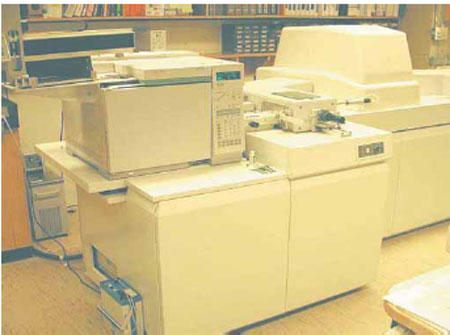
Analytical equipment at the DFO Institute of Ocean Sciences used for measurement of organohalogen compounds.
This project addresses the urgent need from a public perception standpoint to reduce substantially the concentrations of organohalogen contaminants in the flesh of farmed salmon. Alternative commercially-produced diets in which fish oil is significantly replaced by poultry fat, canola oil or blends of these lipid sources, are being fed to farmed salmon in sea pens. It was postulated at the outset of this study, that the alternative diets would dramatically reduce the contaminant concentrations below the range noted for these compounds in wild salmon species and orders of magnitude lower than the national and international guidelines currently in place for human consumption.
Concurrently, we are attempting to show in this field trial that the alternate diets are maintaining adequate flesh levels of n-3 highly unsaturated fatty acids which are known to have human health benefits. Recent results from this collaborative study between DFO researchers and Marine Harvest indicate that PCB concentrations in the flesh of market-size farmed Atlantic salmon can be decreased by up to 10 times when the fish are fed with alternate diets which aren’t extensively based on fish oil. These results along with those from a laboratory study should calm negative public perceptions of farmed salmon flesh quality.
Research team: M. Ikonomou, E. Friesen, D.A. Higgs, and Keng Pee Ang. For information contact Michael Ikonomou (Email: ikonomoum@dfo-mpo.gc.ca). Submitted by DFO (ACRDP).
Jul. ’05-Jun ’07
Researchers reduce flesh contaminants in farmed Atlantic salmon
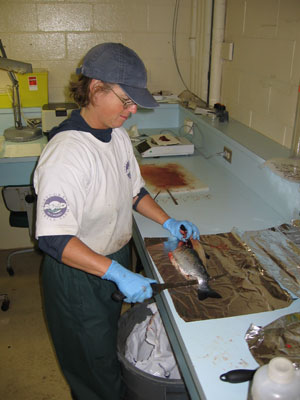
Janice Oakes filleting an Atlantic salmon for subsequent measurement of organohalogen compounds.
A nutrition study was conducted on post-smolt Atlantic salmon to (1) dramatically reduce flesh concentrations of persistent organic pollutants to the lowest levels seen in wild salmon by chronic feeding of diets extensively based on plant and/or animal lipids and, in two cases, plant protein concentrates with contaminant-reduced fish oil and (2) re-instate flesh concentrations of fatty acids of importance for human health in the market-size product to levels observed in wild salmon.
The study was conducted in two phases. In phase 1 (24-weeks), the alternate dietary sources of lipids and proteins to conventional fish oil and fishmeal were employed. In phase 2 (12-weeks), the flesh concentrations of fatty acids essential for human health (DHA and EPA) that were lowered by the treatments in phase 1, were raised by feeding the salmon finishing diets supplemented solely with conventional or contaminant- reduced fish oil. The test dietary lipid and protein sources generally did not influence the growth performance of the fish during phase 1 of the trial relative to fish fed the fishmeal and oil-based control diet. This finding will result in important cost savings for the BC salmon farming industry.
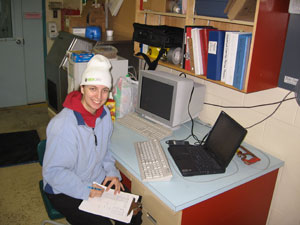
Erin Friesen (Ph.D.student, UBC).
Determinations of flesh organohalogen concentrations, and fatty acid compositions are in progress. The findings of this study should allay public concerns regarding the flesh qualityof farmed Atlantic salmon from a contaminant and fatty acid perspective.
Research team: E. Friesen, D. Higgs, M. Ikonomou, B. Skura, A.P. Farrell, S.K. Balfry, J. Oakes, J. Mann, G. Deacon and D. Maenz. For information contact Dave Higgs (Email: higgsd@dfo-mpo.gc.ca). Submitted by DFO (ACRDP).
Jul. ’05-Mar. ’06
Tracking & characterizing VHS in Canada
VHSV is a highly pathogenic aquatic rhabdovirus that causes devastating losses in wild and cultured fish in Europe, North America and Japan. VHSV infections occur in a broad host range, cause significant economic impact and are listed as notifiable by the Office International des Epizooties (O.I.E). Over the last decade VHSV has been isolated from an increasing number of wild and cultured marine fish populations in the North Pacific and North Atlantic Oceans, and more recently from freshwater fish species in the North American Great Lakes watershed. These novel isolations extend the host and geographic range of VHSV in North America and illustrate the potential impact on fish populations.
To better understand the epidemiology and evolution of VHSV, this study will characterize the genetic diversity of virus isolates taken from marine and freshwater environments of North America. The pathogenicity of viral genetic variants will be assessed and a genomics approach will be utilized to better understand the host response to infection, the development of disease and the recovery from or resistance to, clinical VHSV disease.
Research team : Kyle Garver, Simon Jones, Philip Byrne, and Nellie Gagne. For information contact Kyle Garver (Email: garverK@pac.dfo-mpo.gc.ca). Submitted by DFO (ACRDP).
Apr. ’05-Apr. ’08
Scientists investigate effect of oxidizing dietary lipids on Atlantic salmon
A 12-week study was conducted on small (4g) Atlantic salmon (Salmo salar) to assess the potential adverse consequences of actively oxidizing dietary lipid on the growth, health (haematological and immunological parameters), histopathology, whole body composition, and vitamin E content as well as levels of oxidation products (TBARS).
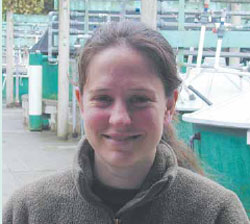
Jill Sutton sur les lieux au Centre MPO/UBC de recherche sur l'aquaculture et l'environnement.
The salmon were fed daily to near satiation (first 28 days) or to satiation (last 56 days) steam pelleted isonitrogenous and isoenergetic dry diets that were supplemented with either unoxidized or pre-oxidized herring oil as measured by the peroxide value (PV; <2 or <2+, 30+, or 50+ meq/kg). Lipid peroxidation in the fishmeal and fish oil was controlled by adding ethoxyquin (150 mg/kg) to the diets that contained the unoxidized lipid (<2 meq/kg). All other diets lacked ethoxyquin and accordingly underwent active oxidation (+). All diets on day 0 contained at least the required level of vitamin E (30 IU/kg). On day 84, vitamin E concentrations were reduced in all diets and those with an initial PV of 30+ and 50+ had significantly lower levels of this vitamin than diets with an initial PV of <2 and <2+. A primary paper reporting these findings will be submitted for publication in November or December, 2006.
Research team: J Sutton, S.K. Balfry, G. Marty, J. Mann, B. Hicks, W. Kay and D.A. Higgs. For information contact Dave Higgs (Email: higgsd@dfo-mpo.gc.ca). Submitted by DFO (ACRDP).
Jul.-Oct. ’06
Atlantic salmon egg research

Atlantic salmon egg at the 4-cell stage (20 hours post-fertilization at 10 ºC).
The British Columbia Atlantic salmon farming industry relies on eggs from resident broodstock. To date the survival and quality of eggs in the industry has not been optimal. This project has examined a number of hatchery production protocols in order to determine methods and techniques to improve handling and increase survival of eggs.
The following research was conducted on Atlantic salmon eggs:
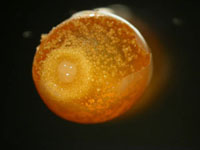
Close-up of an Atlantic salmon embryo; note the developing pectoral fin and gill arches (52 days postfertilization at 6 ºC).
- Mechanical shock
- Mechanical shock & iodine disinfection
- Gamete storage and transport, including minimum sperm density assessment
- Incubation in a range of temperatures from 3 to 14 °C
- Temperature transfer from 8 to 10, 12, & 14 °C at "eyed" and hatch.
- Respiration measurements at 8, 10, & 12 °C

Atlantic salmon embryo at the eyed stage (504 hours post-fertilization at 12 ºC).
Four progress reports (available upon request) were presented at the Northwest Fish Culture Conference, held in Victoria, BC on Dec. 7-9, 2004. Further analyses are ongoing and a complete published report anticipated in 2007.
Mathematical models of embryonic development for Atlantic salmon have been incorporated into a fish culturist computer program called WinSIRP.
Research team: John Jensen (DFO), Maureen Lawrie (Panfish Canada Ltd.), Jamie Gaskill (Marine Harvest Canada Ltd), Bill Damon (DFO), Ted Sweeten (DFO), Joan Bennett (DFO), Bill Mclean (DFO), Jack Smith, Karin Davis. For information contact John Jensen (Email: jensenj@pac.dfo-mpo.gc.ca; Website: http://www-sci.pac.dfo-mpo.gc.ca/aqua/sirp/sirp_e.htm OR http://www-sci.pac.dfo-mpo.gc.ca/aqua/sirp/sirp_f.htm). Submitted by DFO (ACRDP).
Apr. ’03-Jun. ’06
Researchers investigate influence of dissolved gases & temperature on Atlantic salmon broodstock
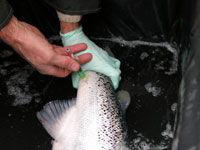
Obtaining blood sample for hormone analysis.
The British Columbia Atlantic salmon farming industry relies on high quality gametes from resident broodstock. It is suspected by the salmon farming industry that dissolved gas levels in sea pen broodstock holding facilities and transportation tanks may be adversely affecting the maturation process and causing poor egg quality and larval abnormalities.
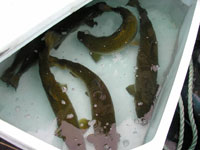
Atlantic salmon broodstock being transferred to holding tanks at the Pacific Biological Station, Nanaimo, BC.
Ongoing tests at the Pacific Biological Station in Nanaimo, BC, using a unique degassing system designed for up to 400 LPM flow-through, have shown that low oxygen levels (i.e. as low as 4 mg/L oxygen) have a direct impact on the broodstock by increasing pre-spawning mortality, influencing the release of sex and stress hormones during the maturation process (i.e. vitellogenesis and ovulation), and reducing egg production and viability.
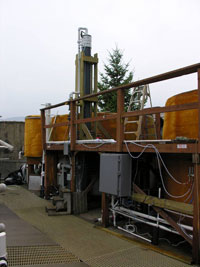
Vacuum degassing column used to reduce dissolved oxygen levels to 4 ppm.
The adverse influence of high water temperature during maturation is also being tested. Finally, the adverse effects of carbon dioxide build-up during fish broodstock transport in closed systems are of concern to the salmon farming industry and tests to filter out or reduce this metabolite are being conducted.
Research team: John Jensen (DFO), Maureen Lawrie (Pan Fish Canada Ltd.), Jamie Gaskill (Marine Harvest Canada Ltd.), Bill Damon (DFO), Ted Sweeten (DFO), Bill Mclean, Jack Smith. For information contact John Jensen (Email: jensenj@pac.dfo-mpo.gc.ca). Submitted by DFO (ACRDP).
Apr. ’05-Jun. ’07
Testing RNA versus DNA-based detection of Atlantic salmon parasites

Atlantic salmon fillet infected with Kudoa thyrsites.
Quantitative PCR (QPCR) methods targeting the 18S rDNA gene (DNA QPCR) and cathepsin L mRNA (RNA QPCR) from Kudoa thyrsites (Gilchrist) were developed and compared to histology for determination of K. thyrsites infection levels in Atlantic salmon, Salmo salar L. Both QPCR tests were specific, reproducible and sensitive down to three copies. However, DNA QPCR was able to detect lower K. thyrsites infection levels than RNA QPCR and histology. The higher threshold for K. thyrsites infection levels detectable via RNA QPCR compared to DNA QPCR appeared to be biological in nature, indicating that fewer copies of cathepsin L mRNA compared to 18S rDNA genes were present in the samples.
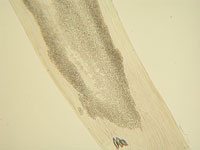
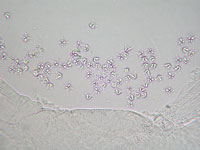
Kudoa thyrsites plasmodia and spores.
However, all three diagnostic methods were highly correlated. Regression analyses comparing DNA QPCR and histology data from two distinct groups of fish showed that the relationship between these two diagnostic methods was reproducible. A logistic regression analysis comparing diagnostic data to a visual assessment of post-mortem flesh quality indicated that histology was the single best predictor of flesh quality, followed by DNA QPCR and then RNA QPCR.
Research team: Valerie Funk, Monique Raap, Ken Sojonky, Simon Jones, John Robinson, Christy Falkenberg, Kristi Miller. For information contact Kristi Miller (Email: millerk@pac.dfo-mpo.gc.ca). Submitted by DFO (ACRDP).
Apr. ’04-Aug. ’06
A Diagnostic tool for early detection of gill parasites in Chinook salmon
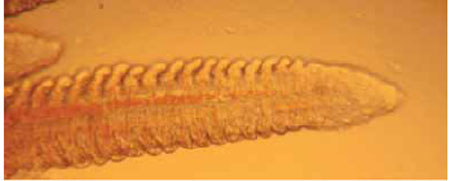
In this project we are developing an Enzyme Linked Immunosorbant Assay (ELISA) designed to be used as a diagnostic tool for the detection and quantification of Loma salmonae infection in Chinook salmon (Oncorhynchus tshawytscha). ELISA utilizes highly sensitive and specific antibodies (Ab) for pathogen detection.
Polyclonal egg yolk antibodies (IgY) were generated by immunization of chickens with purified L. salmonae spores. Polyclonal IgY was extracted from egg yolks beginning at 28 days post immunisation (PI). Purity of extracted IgY was confirmed by SDS-PAGE and western blots of yolk protein extracts. Reactivity of the IgY preparation to L. salmonae was determined through indirect-fl uorescence antibody tests on purified spores. The IgY preparation was found to be pure and highly sensitive and specific for L. salmonae by immunohistochemistry. Biotinylation of capture antibodies was confirmed through dot blotting.
ELISA development is ongoing: however the IgY preparation has shown to be useful for the detection of early Loma salmonae development in Pacific salmon. Immature xenomas in histological sections of heart and gill tissue of infected Chinook salmon (Oncorhynchus tshawytcha) were visualized as early as 4 weeks post-exposure [PE] by immunohistochemistry. Non-lethal, early detection of L. salmonae was obtained by indirect fluorescent microscopy of acetone-fixed gill clips.
Research team: Simon Jones. For information contact Simon Jones (Email: JonesS@pac.dfo-mpo.gc.ca). Submitted by DFO (ACRDP).
Aug. ’05-Dec. ’06
East Coast researchers test furunculosis vaccines for Atlantic salmon
The Bay d’Espoir strain of atypical furunculosis has caused significant financial losses for salmonid farms in Newfoundland. Although much research has been done on furunculosis of salmonids, the Newfoundland Salmonid Growers Association (NSGA) has been anxious to quantify the efficacy of existing furunculosis vaccines under Bay d’Espoir conditions and determine if development of new fish health intervention tools is warranted. A proactive and visionary research program was implemented in 2001 to characterize the nature of the pathogen itself, investigate possible alternative treatments for controlling the pathogen, and the potential for development of new vaccines should the efficacy of existing vaccines prove limited.
The first two years of the research initiative established the taxonomy of the bacterium, its severe pathogenicity, and a disease-challenge model with which to determine commercial vaccine efficacy under laboratory and field conditions. In 2003 and 2004, the vaccine study was performed using controlled laboratory challenges that quantified vaccine efficacy in the laboratory and provided the criteria on which to base selection of vaccines for field trials. Literature reviews have been conducted in the area of usage of both bacteriphage and immunostimulants as alternative health management tools. The research for 2004 – 2006 draws on those laboratory results to conduct actual field trials to the Bay d’Espoir strain of Aeromonas salmonicida subspecies nova at actual Bay d’Espoir salmon farms.
Research team: Atef Mansour, Larry Hammell, Daryl Whelan, and Gilles Olivier. For information contact Atef Mansour (Email: Mansoura@dfo-mpo.gc.ca). Submitted by DFO (ACRDP).
Jun. ’01-Mar. ’06
Can new vaccines reduce KUDOA infection in Atlantic salmon?
Kudoa thyrsites (Myxozoa; Myxosporea) infections have no apparent affect on the fish host while the fish is alive but severe infections in farm reared Atlantic salmon result in deterioration of fillet musculature post-mortem and an unmarketable product.
Two recombinant subunit vaccines were tested for their ability to elicit an immune response and to reduce K. thyrsites infection levels in Atlantic salmon. Both vaccines elicited a long-lasting specific antibody response and a reduction in the number of parasites compared to the saline control group as determined by quantitative PCR and histological examination. The treatment effect was evident up to 1200 degree-days post-exposure of vaccinated fish to the parasite corresponding to 1800 degree-days post-vaccination. In addition, the parasite was detected in a smaller proportion of vaccinated fish compared to controls when using histology as the diagnostic method.
There was evidence that the vaccine adjuvant contributed to the observed efficacy as both diagnostic methods found that average K. thyrsites infection levels were highest in fish injected with saline and lowest in those receiving adjuvant only. These results support the use of these novel, cost-effective recombinant subunit vaccines for reducing K. thyrsites infection levels in farm reared Atlantic salmon. Research team: Valerie Funk, Kristi Miller, Jan Burian, Simon Jones. For information contact Val Funk (Email: valfunk@telus.net). Submitted by DFO (ACRDP).
Apr. ’05-Mar. ’06
DEPOMOD parameter setting and validation for finfish farms in BC
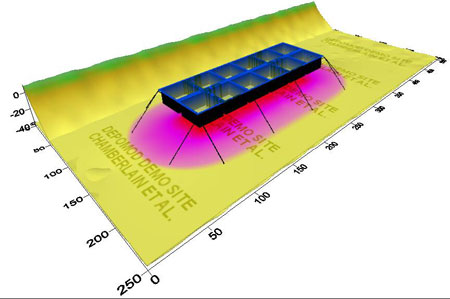
Example of the aquaculture waste impact model DEPOMOD simulation showing the predicted footprint of deposition (g Carbon/m2/d) beneath and around a hypothetical fish farm site.
The initial ACRDP-BCSFA project undertaken during 2004-2005 successfully demonstrated the utility of the waste model DEPOMOD in predicting the effect of marine cage finfish farms on near- field seabed conditions. Significant correlations between predicted relative carbon flux and several measures of benthic effect were observed at one B.C. farm site. However, the investigation identified data limitations and deficiencies in several key parameter settings used in the model. Additionally, all correlations were calculated using model outputs where resuspension processes had not been simulated. The resuspension model in DEPOMOD, when applied, predicted that virtually all of the applied material was exported from the model domain and precluded comparisons of model output with observations.
The results of this project were presented at the DFO peer review meeting (Feb’05) on National Science Advice for Finfish Cage Aquaculture and published as a Canadian Science Advisory Secretariat paper. The recommendations of this paper and meeting identified several research priorities; further validation of the model at different sites; determination of waste feed rates; assessment of the carbon concentration in feed and faecal material; investigation of the importance of resuspension processes; and determination of cage movement due to currents and winds. This project addresses the above research recommendations.
Research team: Dario Stucchi (DFO), Jon Chamberlain (DFO), Mary Ellen Walling (BC Salmon Farmers Association) and Barron Carswell (BC Ministry of Agriculture and Lands). For information contact Dario Stucchi (Email: StucchiD@pac.dfo-mpo.gc.ca). Submitted by DFO (ACRDP).
Sept. ’05-Mar. ’07
Researchers investigate heritage of farm salmon in Bay of Fundy Are they local or European in origin?
Previously published analyses have identified the presence of wholly European and European/North American hybrid salmon in aquaculture escapees obtained from Canadian waters in the Bay of Fundy (BoF) area. Most Canadian producers already screen their broodstock for European ancestry as part of the State of Maine regulations which prohibit stocking of non-North American fish in Maine waters, but some local growers which supply eggs and smolts may not. These non-screened collections were analysed by an independent laboratory to test for European ancestry using methods developed by the USFWS and DFO.
Out of 400 aquaculture salmon surveyed, five salmon exhibited European type mitochondrial DNA and many carried European type nuclear alleles and were identified as having European ancestry by both DFO and USFWS methods. Of 314 wild salmon obtained from the Bay of Fundy area, four exhibited European type mitochondrial DNA and two European-type nuclear alleles, though no individual exhibited more than a single European-marker, and none were identified in the DFO assay as European. Despite this, three wild fish were classified as non-North American using the USFWS method. This analysis indicates that in all but very rare instances, the USFWS test will be more stringent in identifying salmon as European than will the DFO test.
Research team: Rachael Richie, Patrick O’Reilly. For information contact Rachael Ritchie (Email: Rachael.Ritchie@rpc.ca). Submitted by DFO (ACRDP).
Sept. ’04-Dec ’06
Developing a vaccine against microsporidial gill disease in salmon
Loma salmonae (Microsporidia) is the causative agent of microsporidial gill disease (MGD) that affects all species of Pacific salmon (Oncorhynchus) and is the leading cause of mortalities in farm reared chinook salmon. Research has shown that recovered Chinook salmon develop immunity against future infections by L. salmonae thus validating efforts for vaccine development. Development of a recombinant subunit vaccine is the most promising approach for generating a commercially available vaccine against L. salmonae.
A first step in the development of a recombinant vaccine requires the elucidation of parasite derived protein sequences. This will be carried by generating a subtractive cDNA library using both L. salmonae infected and uninfected gill tissue. Immunochemistry and in vitro cellular assays will then identify parasite proteins that are recognized by the host and as such, most likely to provide immunity. The cDNA subtractive library will also lead to the identification of upregulated host genes in response to infection and provide the first direct information of host responses at the molecular level.
Research team: Valerie Funk, Angela Schulze, Simon Jones, Kristi Miller. For information contact Kristi Miller (Email: millerk@pac.dfo-mpo.gc.ca). Submitted by DFO (ACRDP).
Jul. ’06-Mar. ’08
Investigating gastric dilation, air Sacculitis syndrome in farmed steelhead trout
Steelhead growers in Newfoundland have experienced a serious performance problem in the recent past. The syndrome is known as Gastric Dilation, Air Sacculitis (GDAS) where the affected fish suffer from increased mortality, reduced growth, distended abdomens, silvering and a high number of fat droplets surfacing over the net pens. The frequency of GDAS seems to increase with an increase in water salinity and also when water temperature decreases. Other factors are related to nutrition and early maturation and possibly the genetics of the trout strain used in Bay d’Espoir, however no definitive cause is yet known. This prompted the industry to the possibility of obtaining a Danish Steelhead strain to grow.
To maximize the productivity of steelhead aquaculture in Newfoundland, Newfoundland Salmon Growers Association in collaboration with Fisheries and Oceans Canada and Newfoundland Department of Fisheries and Aquaculture are aiming to identify the possible causes of GDAS in farmed steelhead trout in Bay d’Espoir and to suggest possible mitigating measures. Standard diagnostic health testing will be performed as well as histopathological and biochemical indexes during the production cycle. Secondly, laboratory trials to reproduce GDAS will be conducted to identify the role of single and/or multiple factors in the development of the syndrome. Finally, a laboratory comparison between the currently used steelhead strains in Bay d’Espoir and those strains used in Denmark in relation to their susceptibility to GDAS will be performed.
Research team: Atef Mansour, Daryl Whelan, Christopher Parrish, Kurt Gamperl, Elizabeth Barlow. For information contact Atef Mansour (Email: Mansoura@dfo-mpo.gc.ca). Submitted by DFO (ACRDP).
Aug. ’05-Mar. ’08
Using meiofauna to indicate benthic organic enrichment from salmon aquaculture
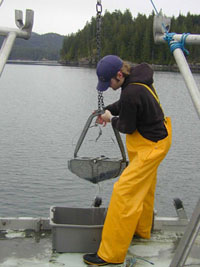
Collection of a grab sample by Shane Petersen.
To date, the impact of fish farm wastes on the benthic environment has mainly been assessed in terms of changes in macrofaunal abundance and diversity. However, recent studies have examined the response of meiofaunal assemblages in regards to aquaculture-derived benthic organic enrichment. Meiofauna (63 to 500 µm) have been used to monitor organic enrichment gradients in association with other anthropogenic applications such as sewage outflows and oil spills. Meiofauna serve as sensitive indicators to environmental pollution as a result of their small size, interstitial existence, naturally-occurring high abundances, direct benthic recruitment, short generation times and asynchronous reproduction.
The objective of this study was to assess the effects of varying levels of organic enrichment associated with aquaculture activities on benthic meiofaunal assemblages in a subtidal setting across a range of substrates within the Broughton Archipelago, British Columbia. Environmental sediment variables and meiofaunal samples were collected within the near- and far-field regions of four salmonid fish farms and one reference site. Delineating the relationship between free sulfide concentration and various meiofauna taxa was emphasized, since this geochemical measure has been previously shown to structure macrofauna communities and is the basis for an organic enrichment classification system recommended for environmental monitoring. Certain meiofaunal groups, such as, Kinorhynchs, Crustaceans, and Polychaetes, showed sharp declines in abundance in an asymptotic fashion with increasing free sulfide concentrations. Other groups, such as, Nematodes and foraminifera, showed a general decline in abundance with increasing organic enrichment with a high amount of variability observed at high free sulfide concentrations. The ratio of Nematodes to copepods was shown to represent the degree of organic loading associated with aquaculture operations.
Research team: T.F. Sutherland, C.D. Levings, S. Petersen, P. Poon,, and E. Piercey. For information contact T.F. Sutherland (Email: sutherlandt@pac.dfo-mpo.gc.ca). Submitted by DFO (ACRDP).
Scientists ground truth acoustic technologies at BC farm site

Benthic acoustic surveys of former fish farm site using Multibeam EM3000 and QTCVIEW technology.
Both acoustic and sediment surveys were carried out in the Broughton Archipelago, British Columbia, in order to map a former aquaculture site and calibrate the acoustic surveys with georeferenced sediment properties. The acoustic surveys included EM3000 Multibeam (including backscatter) and QTCVIEW (Series IV) technologies, while the geotechnical survey entailed Van Veen grab sampling of surface sediments and associated analyses.
The two acoustic technologies were consistent in their ability to identify distinct regions of seafloor characterized by rock outcrops, consolidated substrates, or gel-mud depositional fields. Both Multibeam backscatter data and QTC-VIEW number-coded classifications were extracted across a range of circular areas located at each georeferenced sampling station (radii: 2, 3, 4, 5, 8, 12, 16, 20 meters). Statistical correlations between backscatter and number classifications were observed at the higher ranges of circular extraction areas, where sufficient data was collected from the single-beam QTCVIEW survey at each sampling location. Statistical correlations were observed between backscatter and certain geotechnical properties, such as sediment porosity, sediment grain size fractions (< 2-micron, < 100-micron, silt content), and particulate sulphide content.
The aerial resolution of backscatter extraction was explored in terms of determining a sensitive calibration technique between backscatter and sediment properties. In general the highest r2 values between backscatter and sediment variables were observed across extraction radii between 8 to 20 meters. Such groundtruthing techniques could be used to interpolate seafloor characteristics between sampling stations and provide a steering tool for sampling designs associated with benthic monitoring programs.
Research team: T.F. Sutherland, J. Galloway, R. Loschiavo, C.D. Levings, and R. Hare. For information contact T.F. Sutherland (sutherlandt@pac.dfo-mpo). Submitted by DFO (ACRDP).
BC researchers test efficacy of IHN vaccine in Atlantic salmon
IHNV is an aquatic rhabdovirus that causes significant mortality in salmon and trout. In the marine environment, IHNV is highly infective, pathogenic and virulent for Atlantic salmon.
In British Columbia, IHNV is the most economically important viral pathogen of farmed salmonids. Since the introduction of Atlantic salmon to the BC coast in the mid 1980’s, there have been two serious outbreaks of IHN in farmed Atlantic salmon: 1992-1996 and 2001-2003. During the latest epizootic, mortalities were greater than 70% in fish less than 1 kg and averaged 40-50% when fish were larger than 1 kg. Thirty-six farm sites were diagnosed with IHNV during this epizootic. The estimated economic loss resulting from both epizootics was $40 million in inventory representing $200 million in lost sales.
The source of the IHNV introduction to farmed salmon is unknown but epidemiological investigations have been useful in identifying potential mechanisms of virus transmission and have led to implementation of effective IHNV biocontainment strategies on farm sites However, as in the case for other viral diseases, cyclical epizootics of IHNV are expected to continue to occur in farmed salmon. To interrupt the disease cycle, vaccines are required in addition to existing good fish health management practice tools. The goal of this study is to test the efficacy and duration of protection of an inactivated IHNV vaccine administered in combination with a multivalent bacteria vaccine used routinelyby the industry.
Research team: Garth Traxler, Kyle Garver, Val Funk. For information contact Garth Traxler (Email: traxlerg@dfo-mpo.gc.ca). Submitted by DFO (ACRDP).
Jul. ’06-May ’08

Immunizing salmon with IHNV vaccine.
East Coast researchers compare performance of local and imported salmon strains at PEI facility
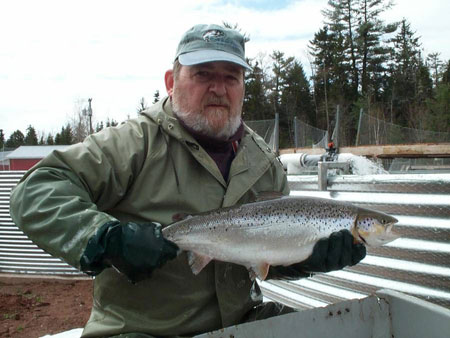
Recently, marine diseases, especially Infectious Salmon Anemia virus (ISAv), have resulted in the destruction of most seawater cage maintained broodstock in New Brunswick. This problem prompted a move toward maintenance of land-based broodstock to supply eggs. Hatchery reared pedigreed smolts are transferred to either freshwater or ground seawater supplied shore based tank fields. These smolts are retained for two years, selected individuals are spawned and the eggs returned to the smolt production hatcheries where they are on-grown to supply seedstock to the marine farms. This broodstock have the advantage of being isolated from Infectious Salmon Anemia Virus and other seawater disease exposure.
In this project, Dover Fish Farm (a disease free landbased broodstock site in PEI) is developing a pedigreed Saint John River (NB) stock to supply ISAv free ova to New Brunswick and else where. Furthermore, European pedigreed ova have been imported for comparative performance evaluation. If superior performance is demonstrated, all female triploid sterile ova could be supplied to New Brunswick and other Maritime farming areas to increase industry competitiveness. Similar markets for diploid and triploid European strains could be developed in BC, and Chile. This project aims is to improve the competitiveness of the Atlantic coast salmon aquaculture industry by giving farmers better access to disease free ova as seedstock from the best strains. Furthermore, applying landbased broodstock methods reduces the risk of catastrophic broodstock loss due to disease in seawater cages.
Research Team: Ken and Leon Moyaert, Dover Fish Hatchery Ltd (PEI), Keng Pee Ang, Stolt Sea Farm Ltd. (BC) and Chris Mills, (DFO), Wilfred Young-lai. For information contact Brian Glebe (E-mail: GlebeB@mar.dfo-mpo.gc.ca). Submitted by DFO (ACRDP).
Development of a new assay for predicting grilse in Atlantic salmon
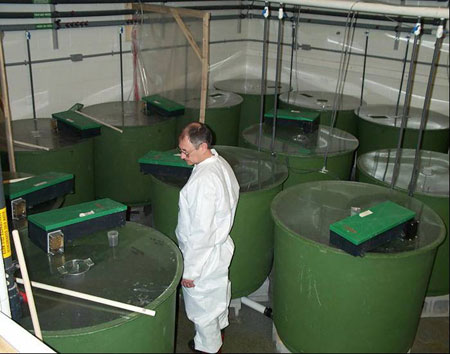
A previous ACRDP project found an association between levels of Insulin like Growth Factor -1 (IGF-1) and the level of grilsification. Unlike testosterone and vitellogenin, which also correlated with grilsification levels, IGF-1 data did not require knowledge of the sex of the fish for interpretation. Unfortunately, the assay for IGF-1 is a radioimmunoassay which, because it involves the use of radioactivity, is cumbersome and its potential benefits have not been transferred to industry.
For industry to benefit more fully from the initial research, it is necessary to develop an assay for IGF-1 levels which is as sensitive as the radioimmunoassay but easier and less expensive to perform. Industry will further benefit from research extending the scope to the wider application of the assay on the production and broodstock phases of the salmon aquaculture operation. In the future, industry may be able to modify the tools for applications in alternate species such as cod, haddock and halibut.
This project aims to:
- Develop and standardize a simple, cost effective assay for measurement of IGF-1 levels in Atlantic salmon.
- Study the levels of IGF-1 in production fish several months before harvest to assess the application of the IGF-1 assay for predicting grilse in Atlantic salmon before the on-set of early maturation.
- Study the levels of IGF-1 in broodstock fish in the months and years before grilse/salmon grading at 3 years of age to assess the application of the IGF-1 assay for predicting grilse in Atlantic salmon broodstock before onset of early maturation.
- Provide industry with inexpensive, rapid and reliable protocols for prediction of grilse in broodstock and production lots.
Research Team: Jake Elliott, Cooke Aquaculture Ltd (NB), Rachael Ritchie, Research and Productivity Council, Molecular Biology Group (NB). For information contact Brian Glebe (E-mail: GlebeB@mar.dfo-mpo.gc.ca). Submitted by DFO (ACRDP).
Jul. ’05-Mar. ’07
DNA identification of chinook salmon the focus of BC research
Sophisticated selection programs such as those used for agricultural animals depend on the documentation of a pedigree for the strain under selection: the ability to identify an individual to its family provides both a more accurate determination of its genetic merit and a means to minimize inbreeding within the strain.
Maintenance of pedigrees for fish, with their large fecundity and requirement for aquatic habitat, poses novel problems for the breeder. Eggs and juveniles must be reared in separate family groups until marking or tagging can be carried out, which increases expense of the hatchery rearing phase, confounds environmental (rearing tank) and genetic influences on phenotypic traits, and stresses the fish by early marking.
Development of highly polymorphic codominant genetic markers (microsatellite loci) provides a method for estimation of relatedness among individuals without tags. Thus, molecular identification of fish to parents and/or family can be used to avoid the necessity of rearing full and halfsib family groups in separate tanks, greatly reducing rearing costs while simultaneously improving estimation of genetic merit in breeding programs. We will develop a most cost-effective suite of 6-10 loci that can be used for family assignment in domesticated BC chinook strains on an ongoing basis.
Research team: R. Withler, T. Rundle, B. Swift and R. Peterson. For information contact R. Withler (Email: withlerr@pac.dfo-mpo.gc.ca). Submitted by DFO (ACRDP).
Sept. ’06-Mar. ’08
Identifying genetic markers for early maturation in farmed Atlantic salmon
Early maturation of farmed fish, resulting in lost production and higher costs, is a major impediment in finfish aquaculture. Age-at-maturity in salmonids is a complex quantitative trait affected by numerous unidentified genes as well as environmental conditions. The improved growth and energy status experienced by farmed Atlantic salmon leads to a reduction in age at maturity relative to the wild populations from which they were derived. Atlantic salmon in BC are derived from the Mowi strain that originated in Norway and was imported into BC in the early 1980s. Based on the history of other domesticated Atlantic strains around the world, the loss of fish due to early maturation in BC could eventually reach 50% or higher.
In this project, we will test associations between early maturation and genetic markers (termed QTLs) developed by researchers at the University of Guelph to determine if these markers may be useful in identifying and selecting for fish with a genetic propensity for late maturation. The putative QTLs for age-at-maturity in Atlantic salmon have been identified in North American-origin Atlantic salmon in eastern Canada. In this study, we will determine if the QTLs identify major genes associated with age-at-maturity in an European-origin strain.
Research team: R. Withler (DFO), R. Danzmann (U. Guelph), M. Ferguson (U. Guelph), S. Fukui (Mainstream Canada), B. Swift (Tri-Gen Fish Improvements). For information contact R. Withler (Email: withlerr@pac.dfo-mpo.gc.ca). Submitted by DFO (ACRDP).
Jan. ’07-May ’08
Study to examine emamectin residues in SLICE treated salmon
SLICE® (active ingredient, emamectin benzoate) is used for the control of sea lice in farmed salmon. Sea lice are externally located, parasitic copepods. In commercial operations SLICE® is fed to fish, in the form of medicated feed, for 7 days. Emamectin is metabolized to inactive compounds by the fish and then excreted. Sea lice are considered a potential vector for the transmission of Infectious Salmon Anemia virus (ISAV). Elevated sea lice infestation is associated with increased stress, poor growth and increased susceptibility to opportunistic pathogens.
SLICE® was submitted for approval in the US and Canada in 1999; the approval process has not been completed. This drug can be sold to veterinarians on a case-by-case basis through Health Canada’s Veterinary Drugs Directorate’s (VDD’s) Emergency Drug Release Program (EDR). VDD established a maximum residue limit (MRL) of 42 parts per billion (ppb).
This study will examine the emamectin residues in salmon muscle from salmon treated with SLICE® in conventional commercial operations (salmon cultured in sea cages) or in a controlled laboratory setting (indoor tanks). In each case, selected animals will be collected for up to 45 days following SLICE® treatment and tissues submitted for SLICE® content analysis.
Information from this project will assist Health Canada, CFIA and provincial government officials in their roles as regulators. Results from this project will also aid health and disease management decisions by aquaculture veterinarians, producers and Fisheries and Oceans personnel with regard to the use of SLICE® in commercial operations.
Research team: Phil Byrne (DFO), Province of New Brunswick, New Brunswick Salmon Growers Association. For information contact Phil Byrne (Email: byrne@dfo-mpo.gc.ca). Submitted by DFO (ACRDP).
Jul. ’06-Mar. ’07
Clinical field trials focus on salmon and cod in Newfoundland
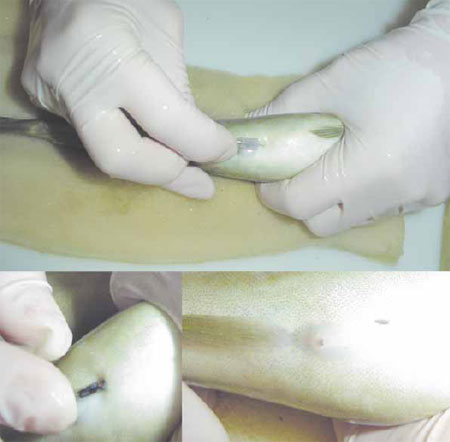
PIT (Passive Integrated Transponder) tagging of Atlantic Cod
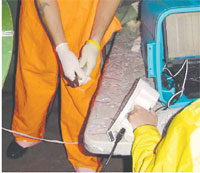
Scanning PIT tags to obtain baseline information in an Atlantic Salmon and vaccines used in salmon aquaculture
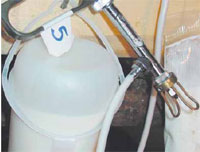
The overall objective of this clinical trial is to provide the industry with evidence to critically evaluate the potential for adverse effects of adjuvants contained in different vaccines in Atlantic Cod and Atlantic Salmon. Furthermore, the role of smoltification in Atlantic salmon as well as timing of sea transfer in Atlantic Cod will be included in the study design. These objectives will be accomplished by using double-blind, randomized clinical trials under field conditions and evaluating the outcomes at the individual fish level using PIT (Passive Integrated Transponder) tags. The outcomes of interest here are growth, survival and carcass characteristics for individual fish. The fish are followed through to harvest and collection is expected to start in the next year.
Research team: Larry Hammell (UPEI AVC), Daryl Whelan (NLDFA), Nicole O’Brien (NLDFA). For information contact Larry Hammell (Email: lhammell@upei.ca). Submitted by ACOA-AIF.
Sept. ’04-Sept. ’08
Researchers identify Atlantic salmon families using DNA methods
We will introduce the use of highly polymorphic microsatellite loci in BC Atlantic salmon strains for molecular identification of offspring to their parents in an ongoing selective breeding program (SBP). This will enable the communal rearing of juveniles from 150 fullsib families, eliminating the "common-environment" effect of tanks and the need for single family tanks in the hatchery.
Multi-locus DNA genotypes from all parents spawned in 2004 and from 6000 of their progeny sampled before transfer to saltwater will be used to identify the progeny to family (i.e. the correct pair of parents). The juveniles will be tagged at the time of tissue sampling for subsequent identification to family, allowing future data collection and spawning to be carried out with full pedigree knowledge. There are many polymorphic microsatellite loci available for use but the feasibility of implementing molecular identification of juveniles on an on-going basis depends on the cost of analysis. This in turn depends on the number of loci that need to be assayed for accurate family assignment. We will evaluate the polymorphism at 12 to 15 loci in the SBP and identify the most cost-effective suite of 6-10 loci that can be used for family assignment.
Researcher team: R. Withler, S. Fukui, B. Swift and R. Peterson. For information contact R. Withler (Email: withlerr@pac.dfo-mpo.gc.ca). Submitted by DFO (ACRDP).
Apr. ’05-May ’07
Genetic factors affecting susceptibility of salmon to Infectious Hematopoietic Necrosis virus
Infectious hematopoietic necrosis virus (IHNv) occurs naturally in the BC marine environment.
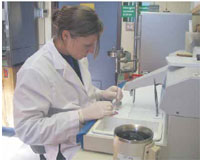
Part I of this study demonstrated that while farmed Atlantic salmon have little immunity to IHNv, Pacific salmon exhibit a species-specific range of resistance to the virus. Information on the molecular basis of IHNv resistance/susceptibility in salmon could be useful in the development of therapeutics and vaccines capable of reducing IHN outbreaks in Atlantic salmon.
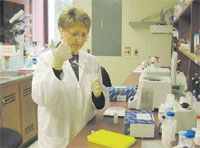
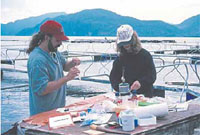
The objective of this study was to identify genetic factors which influence the resistance of various salmon species to IHNv. Juvenile Atlantic, Chum, Coho, and Sockeye were infected with IHNv, and the activity of over 15,000 genes that regulate immune pathways was evaluated in each species.
The results of this study indicate that differences in IHNv susceptibility in salmon may not stem from the overall strength of the immune response. Instead, these differences in susceptibility may result from species-specific differences in the ability to prevent the virus from entering the host cells – and perhaps differences in which immune pathways the species uses to defend against the virus once it has entered.
Research team: Garth Traxler and Kristina Miller (DFO). For information contact Garth Traxler (Email: traxlerg@dfo-mpo.gc.ca). Submitted by BCARDC Aqua-E.
Three strains of Atlantics tested for triploid viability
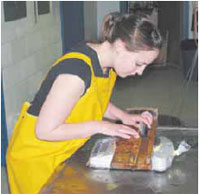
MSc candidate Heather Mouland measuring a triploid Atlantic salmon.
Triploid salmon are sterile, and can be used to eliminate production losses associated with pre-harvest maturation as well as concerns with the feral spawning of escaped farmed fish. This project evaluates various aspects of the culture performance of triploid Atlantic salmon. A comparison of three strains of triploid salmon (domesticated European, domesticated North American and wild North American) revealed significant strain effects on triploid post-smolt growth in a 12-week tank trial, with the wild triploids exhibiting the fastest growth rates. A long-term parallel trial in commercial sea cages showed triploid wild-strain salmon to grow just as well as diploids of the same strain, but both were inferior to diploid domesticated fish. These results point to the importance of selecting the best strains with which to evaluate triploid performance.
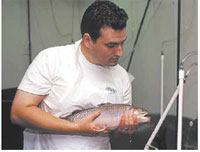
PhD candidate Charles Sacobie holding a triploid brook trout.
Experiments evaluating dietary energy and phosphorus utilization by triploid salmon are currently in progress. Pilot studies with triploid brook trout suggest that they do not perform equally to diploids when fed similar diets and therefore triploids may have different dietary requirements.
Research team: Tillmann Benfey (UNB), Santosh Lall (NRC IMB), Brian Glebe (DFO SABS), Charles Sacobie (UNB), Heather Mouland (UNB). For information contact Tillman Benfey (Email: benfey@unb.ca). Submitted by NSERC.
Sept. ’03-Mar. ’07
Incorporating vegetable oils in salmonid feed reduces contaminants and lowers production costs
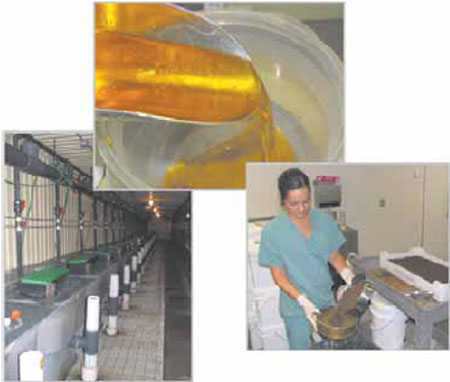
Alma Aquaculture Research Station - Canola oil - Experimental production.
The research project aims to develop nutritional strategies for minimizing potential contamination of salmonids by persistent organic pollutants (POPs) and heavy metals. Since these pollutants are fat soluble, efforts have been directed at replacing fish oil (the main source of contaminants) with alternative fat sources in order to minimize bioaccumulation of these contaminants in tissues.
Different vegetable oils have been tested in the feed, namely soy oil, canola oil and canola oil supplemented with long-chain polyunsaturated fatty acids (LCPUFAs) from marine sources, combined with varying protein-to-fat ratios capable of supporting growth during the phase when the bulk of body fat is accumulated. A short finishing period completed the study in order to restore the levels of LCPUFAs beneficial to humans. Assimilation of the new fat sources was evaluated through digestibility studies on rainbow trout in freshwater. Analyses of growth, finishing and digestibility are under way. An organoleptic study, based on sensory properties of a product, involving taste, colour, odour and feel, demonstrated that vegetable oils do not influence fish palatability for consumers. Finally, a brief economic study is being conducted to determine the industrial costs of using vegetable oil, generally less expensive and more readily available than fish oil.
Research Team: G.W. Vandenberg, A. Bélanger-Lamonde, J. Bailey, A. Desmeules, and É . Proulx (Laval U.); P. Ayotte, Y. Chouinard, É. Dewailly, A. Leblanc, and J.-P.Weber (Institut National de Santé Publique du Québec - INSPQ); D. Bureau (U. Guelph). For Information contact Grant Vandenberg (Email: Grant.Vandenberg@san.ulaval.ca). Submitted by AquaNet.
Aug. ’05-Apr. ’06
A faster diagnosis for Infectious Hematopoietic Necrosis

Infectious Hematopoietic Necrosis (IHN) is a viral disease capable of causing high mortality rates among juvenile farmed Atlantic salmon. The clinical signs of IHN are similar to several other diseases of Atlantic salmon. Laboratory testing is therefore required to confirm IHN. Currently, virus isolation (VI) via cell culture is recognized as the most effective method to detect the IHN virus (IHNv). However, VI requires an average of 15.7 days to complete the laboratory diagnosis. This time lapse contributes significantly to the spread of the disease.
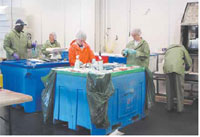
Initial laboratory testing has suggested that use of the reverse transcriptase polymerase chain reaction (RT-PCR) assay could reduce the time required for diagnosis of IHN to 48 hours from the time of sample collection. The objective of this study was to evaluate RT-PCR using samples collected in the field to determine its reliability as a more rapid diagnostic tool for detecting IHNv in farmed salmon populations.
Fish from 3 farm sites were tested for IHNv and the reliability of RT-PCR for IHNv detection, its performance was compared to the VI test. The performance of RT-PCR on fresh or frozen samples was equivalent to that of VI. Given the short time from IHNv exposure to onset of clinical signs and mortality, the shorter diagnosis time achieved via RT-PCR will permit earlier management changes that may reduce spread of disease.
Research team: Larry Hammell, Sonja Saksida, Grace Karreman, Joanne Constantine, John Robinson, Garth Traxler, Ian Dohoo and Henrik Stryhn. For information contact Larry Hammell (Email: lhammell@upei.ca). Submitted by UPEI, Centre for Aquatic Health Sciences.
BC researchers investigate effect of plant-derived oils on chinook salmon
The objective of this project is to replace in whole or in part marine finfish based oils in salmon diets with plant-derived oils, which are much less expensive, and address concerns of contaminants. The research focuses on ensuring that these alternative oils improve, or at least do not harm, the health, growth and performance of fish. Previous research indicates that a diet balanced in fish and plant-derived oils actually enhances performance. This project examines the effects of canola oil on the performance of several strains of juvenile Chinook salmon, by feeding fish several diets with varying proportions of canola and anchovy oil, and monitoring growth, health, ion regulatory development, seawater tolerance and swimming performance.
In addition to filling knowledge gaps about the effects of alternate dietary lipids for salmon aquaculture, the research is providing valuable information for husbandry practices of Chinook salmon, a fish species that is prevalent throughout British Columbia. Reared in hatcheries as part of stock enhancement programs, an improved alternate diet is expected to increase the health and immune system of the juveniles and their survival in the wild.
Research team: Colin Brauner and Patricia Schulte (UBC), Robert Devlin and David Higgs (DFO). For information contact Colin Brauner (Email: brauner@zoology.ubc.ca ). Submitted by AquaNet.
Evaluating current and new diagnostic tests for Infectious Salmon Anemia Virus - Phase 2
Infectious Salmon Anemia (ISA) is a viral disease that has caused major problems for the Canadian and the international salmon aquaculture sector. There are number of diagnostic tests available to identify infected fish, yet there had been no systematic evaluation of the diagnostic tests available and multiple tests often gave contradictory and confusing results.
To combat this, this project carried out a thorough, structured evaluation of all tests in common use and their ability to correctly identify infected fish (i.e. sensitivity of the test) and non-infected fish (i.e. specificity of the test). Six research institutions participated, with four collectively representing all of the fish health diagnostic laboratories in Eastern Canada.
The research designed superior disease control programs and initial results contributed to a re-evaluation of the disease surveillance program in New Brunswick and increased efforts to standardize tests for different diseases in salmonids. At an industry-wide ISA workshop in 2003, the results of this work were described as the most important research contribution for the industry. Results led to the development of a program of PCR (polymerase chain reaction) standardization by two labs in Canada and one in the USA. A follow-up meeting with federal, provincial and USA government institutions in 2003, led to a revision of control policies and a review of future directions.
Research team: Ian Dohoo, Larry Hammell, and Henrik Stryhn (UPEI - AVC). For information contact Ian Dohoo (Email: dohoo@upei.ca). Submitted by AquaNet.
Researchers identify molecular markers of efficient immune system in Atlantic salmon
Researchers investigated whether different families from the Atlantic Salmon Broodstock Program differed in their susceptibility to two pathogens. This research led to the identification of genetic markers and physiological indicators associated with disease resistance, and built the foundation for Marker Assisted Selection (MAS) in Atlantic salmon broodstock.
Associated gene mapping efforts conducted in collaboration with this research team localized a large number of anonymous genetic markers onto the Atlantic salmon genetic map. This genetic map, and the targeted gene mapping of specific stress tolerance, disease resistance, and growth related genes in Atlantic salmon, Arctic charr, and rainbow trout, provided a solid basis for the identification of quantitative trait locus regions associated with ISAv resistance in Atlantic salmon. Knowing what regions of the genome conferred resistance or susceptibility to ISAv in Atlantic salmon allowed the integration of this information into the selective breeding program for Atlantic salmon in New Brunswick and increased the rate of genetic improvement (i.e. increase ISAv resistance) after the whole broodstock has been genotyped.
Research Team: Roy G. Danzmann, Patrick T.K. Woo, and Moira M. Ferguson (U. Guelph), Brian D. Glebe (U. Guelph), Don Rainnie (UPEI-AVC), George K. Iwama (NRC-IMB). For information contact Roy Danzmann (Email: rdanzman@uoguelph.ca). Submitted by AquaNet.
Mar. ’03-Mar. ’06
Research aims to optimize fish welfare during live-haul

Tanker truck unloading smolts into the Sterling Carrier.
Optimizing fish welfare during high density transports is essential from both moral and economic standpoints. In partnership with Batchelor Bay Management, Stolt Sea Farms, and Marine Harvest, experiments were carried out onboard the Sterling Carrier operating on the west coast of British Columbia. It is a state of- the-art live-haul vessel capable of carrying in excess of 200,000 pounds of fish per trip.
The team monitored fish behaviour and physiological parameters during the commercial live-haul of adult and juvenile Atlantic salmon. Preliminary analysis of water quality and plasma constituents of smolts supports previous studies that transport by a live-haul vessel allows the fish to recover rapidly from the stress accumulated during closed transport by truck from the hatchery to the Sterling Carrier. Underwater video footage is being analysed to detect any correlations between behavioural responses and physiological measures of stress.

The measurement of bulk oxygen uptake rates during the transport of adult fish was used to non-lethally assess the overall stress level of fish in the live-holds. Changes in oxygen uptake rates would reflect elevated metabolic rate of the fish if they are stressed during the transport procedure. Results showed a significant recovery within two hours of an initial loading stress, and indicated low stress levels were maintained for the remainder of the transport.
Research team: A. P. Farrell, S. Tang, M. Nomura, C. Brauner and N. von Keyserlingk (UBC), C. Wood (McMaster U.), K. Sloman (Plymouth U., UK). For information contact Tony Farrell (Email: farrellt@interchange.ubc.ca ). Submitted by AquaNet.
Jan. ‘05 - Sept. ‘07
Vaccines and therapeutic assessments undergo field trials on East Coast
The effectiveness of therapies or health management techniques in salmon farming are influenced by husbandry, environmental, and other site-specific factors that are not easily identified or controlled in field trials, particularly when utilizing production sites for the trials. This study addresses the need for clinical field trials to critically assess the use of vaccines and chemotherapeutants in aquaculture. The objective of the clinical trial system is to provide the industry with highly credible evidence of the effectiveness of selected vaccines using randomized, double-blind clinical trials under field conditions, as well as individual growth, survival and efficiency as outcomes at the individual fish level.
A rigorous vaccine trial is being carried out to generate evidence of the impact the infectious salmon anemia virus (ISA) would have on a vaccinated population. Comparisons were made between vaccine groups to determine their effect on growth and survival. The natural influences of environment, husbandry, and host characteristics unique to the study sites allow for the evaluation of vaccines under different production situations.
This knowledge about vaccine effectiveness will enable regulators and industry to appreciate how changes in control policies may affect the financial impacts of ISA as well as provide a model for future study populations to be established for comparison of survival and growth in other regions or under new conditions such as new diseases.
Research team: Larry Hammell, Henrik Stryhn, Ian Dohoo (UPEIAVC). For information contact Larry Hammell (Email: lhammell@upei.ca). Submitted by AquaNet.
Nov. ‘04 - Aug. ‘07
Researchers study innovative recirculation systems

The nitrification, degassing and oxygenation characteristics of the horizontal moving-bed biofilter were investigated in a 6.2m long x 3m wide x 1.3 m deep unit in operation at a commercial salmon smolt hatchery. Buoyant plastic rings were used as the support media for the nitrifying biofilm and rising air bubbles kept the two cells of the biofilterwell mixed. The air bubbles also maintained the water saturated in oxygen and provided significant removal of carbon dioxide. By combining nitrification, degassing and oxygenation in one low-head unit, the horizontal moving-bed biofilter offers new design opportunities for reducing the pumping cost and the number of unit operations of recirculating aquaculture farms.
The hydrodynamic characteristics of multi-drain fish rearing tanks were also investigated using 1.5m and 5m tanks. The rotational velocity in these tanks generates a secondary radial flow along the floor that carries settled particles to the central drain. The shape of the tangential velocity profile determines the strength of the secondary flow and therefore whether the tank is self-cleaning. It is shown that the proposed triple-drain tank design provides greater flexibility than the conventional double-drain designs for controlling tank hydrodynamics.
Research team: Michel F. Couturier (UNB). For information contact Michel Couturier (Email: cout@unb.ca). Submitted by NB DAFA.
Sept. ’04-Mar. ’06.
Feeding trials aim to reduce fish farm waste at the source
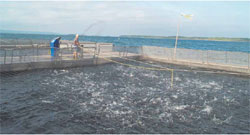
Trout farmer hand-feeding fish. Feeds and feeding systems can directly impact both the benthic and pelagic environments surrounding freshwater aquaculture sites.
The reduction of solid, nitrogen (N), and phosphorus (P) wastes from aquaculture is key to ensuring the long-term sustainability of the industry in Canada. Most wastes are from biological and dietary origins, so this project focused on waste reduction strategies at the source, through genetic improvements and by altering the feeds and feeding regimens.
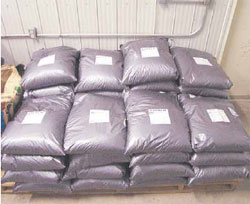
Feed formulations were manipulated in an attempt to reduce fecal BOD.
Investigators and industry partners from Canada and other countries are collaborating on this project, bringing complimentary strengths in nutrition, genetics, physiology, growth modeling and environmental impact assessment. Feeding trials were carried out to examine the effects of diet composition, fish species and life stage on feed utilization and waste outputs. A nutrient-flow growth model was adapted for salmonids, and an environmental decision-support system was developed for cage culture in freshwater. A model was constructed to predict solid and soluble P wastes. BOD impacts from various feed formulations were quantified to help calculate hypolimnetic impacts of aquaculture operations, and stable isotope analysis was used to track fecal dispersion. The research team is also involved in developing bioenergetics models to predict waste outputs of an experimental cage farm operated by DFO researchers in the Experimental Lakes site in Northern Manitoba.
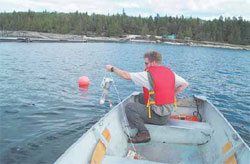
Post Doc Gregor Reid is collecting water samples adjacent to a commercial farm site to monitor diel fluctuations in dissolved phosphorus levels.
The research findings will help Canadian feed manufacturers improve feed formulae and production models, and will assist regulators in establishing guidelines to both manage and mitigate the environmental impact of fish culture operations.
Research team: Dominique P. Bureau, Muriel Mambrini, C.F.M. de Lange, Barbara Grisdale-Helland, Richard D. Moccia, Ståle J. Helland, Stephen Birkett, Patricia Wright. For information contact Dominique P. Bureau (Email: dbureau@uoguelph.ca). Submitted by AquaNet.
Apr. ’03-Aug. ’06
Genomic approaches to aquatic animal disease management
As with any intensively cultured species, farmed fish are subject to infectious diseases. At the National Research Council of Canada, Institutes for Marine Biosciences (Halifax) and Biological Sciences (Ottawa), a team of researchers is working with academic and industrial partners to develop efficient new tools and technologies for fish health management.
The Genomic Approaches to Aquatic Animal Disease Management program is intensive genomics and proteomics research focused on the Aeromonas salmonicida and Atlantic salmon (Salmo salar) model system. Results of that research include a complete genome sequence of A. salmonicida, insight into the proteome of this bacterium, knockout strains and a whole bacterial genome DNA microarray. The team has also developed a salmon immune system-targeted cDNA microarray, and array-based snapshots of the host transcriptome in response to infection. The team is developing rationally-targeted antigens and delivery systems for vaccine and investigating the role of aquaculturerelated stressors on the efficacy of the targeted vaccines to ensure these vaccines will be of use in real-life situations.
The program involves 13 laboratories in the NRC Institutes, along with Dr. Rafael Garduño at Dalhousie University. The team uses a broad range of investigative techniques including: genome sequencing, microarray, advanced mass spectrometry, protein expression, proteomics, metabolomics, nuclear magnetic resonance imaging and bioinformatics, among others.
Research team: Laura Brown (IMB-NRC). Andrew Dacanay (IMB), John Nash (IBS), Laura Brown (IMB), Devanand Pinto (IMB), Roger Ebanks (IMB), Jianjun Li (IBS), Eleonora Altman (IBS), Michael Reith (IMB), Jessica Boyd (IMB), Vanya Ewart (IMB), Kelly Soanes (IMB), Stewart Johnson (IMB), Neil Ross (IMB), John Walter (IMB), Evelyn Soo (IMB), Rafael Garduño (Dalhousie U.), Luis Afonso (IMB). For information contact Laura Brown (Email: Laura.brown@nrc-cnrc.gc.ca). Submitted by NRC-IMB.
Apr. ’05-Mar. ’08
Genomics research in British Columbia
Genome British Columbia is currently supporting two projects with interest to the finfish aquaculture industry. These two projects are cGRASP and GRASP and both aim to further our understanding of finfish genetics.
The Genomics Research on Atlantic Salmon Project, or GRASP, is working towards providing genetic answers to questions around Atlantic salmon reproduction, growth and health. The project is melding new research with previous studies to create a genome map for Atlantic salmon and analyzing the genome itself to examine evolution rates. Measurements of gene expression are also being examined to further understand the interaction between salmon and several environmental variables.
The Consortium for Genomic Research on All Salmonids Project, or cGRASP, aims to expand the knowledge base of genomics for Atlantic salmon and rainbow trout and to develop such a resource for brook charr and rainbow smelt. Information gathered through this project will further responsible development of aquaculture protocols for all four of these species.
The knowledge provided by these two projects will help to ensure sustainability and success of finfish aquaculture in Canada.
Researchers: Ben F. Koop (UVic) and William S. Davidson (SFU).For information contact Wllliam Davidson (Email: william_davidson@sfu.ca ; Websites: http://web.uvic.ca/cbr/grasp/ or www.genomebc.ca). Submitted by Genome BC.
- Date modified: